What Was The Baffler?
The Baffler was (and still is!) a totally unauthorized magazine that some friends and I started back in 1988. It was dedicated, we used to say, to giving the chancers, chiselers, mountebanks and buffoons who make American culture their due before a literate public. Over the years, from our hideout in the South Side of Chicago, my colleagues and I assailed phony radicalism, the “culture trust,” management literature and its fantasies, the hallucinations of the pseudopopulist right, and nearly everything associated with alternative culture, postmodern academia, and what we now call “neoliberalism.” We simply refused to be optimistic about the developments—the Internet, the bull market—that everyone in the 1990s insisted were bringing us total democracy and utopian prosperity.
Some people found that refusal shocking at the time. Eventually, however, the outrageous arguments that The Baffler made in the 1990s would be vindicated over and over again. Every one of us is a shrieking radical today, and it doesn’t matter at all. Every one of us resists hierarchies; we blog and we tweet; we post and we comment; we comb our hair to the left and pierce ourselves to the right—and the rich are richer than ever. Cultural radicalism cohabits unproblematically with concentrated economic power.
Here is how we described the context in which The Baffler appeared in our first anthology, Commodify Your Dissent (published in 1997):
“Thanks to the forces of academic professionalization, cultural criticism had become specialized and intentionally obscure. The authority of high culture had collapsed, but the high-culture critics had no intention of allowing their authority to collapse with it. Instead they abandoned the mundane project of enlightenment and aimed for bafflement, for a style that made much of its own radicalism but had astonishingly little to say about the conditions of life in twentieth-century America. We set out to puncture their pretentions and to beat them at their own game.
. . .
“What we thought was really eerie, though, was the way mass culture reflected the high critics’ priorities. While they spoke proudly of their own subversiveness and turned out account after account of the liberating potential of each act of consuming, the culture industry itself grabbed with both hands at the golden promise of rebellion-through-consumption. The more closely American speech was brought under centralized corporate control, the more strenuously did our advertising, TV sitcoms, and even our management literature insist on the virtue and widespread availability of revolution. In economic terms, the nineties were years of unprecedented consolidation; in terms of official culture, they were years of unprecedented radical-talk. For us they were a great time to be making trouble.”
The last issue of The Baffler that I edited appeared in 2010.
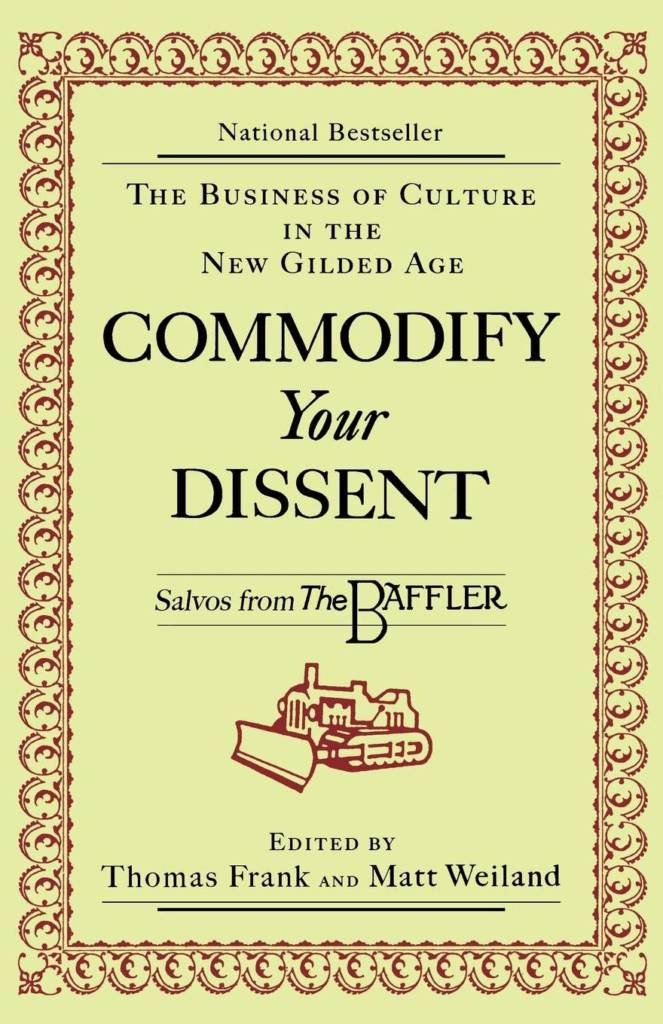
So, what was The Baffler, and how did such a tiny magazine come to matter so much in the 1990s?
A few years ago, my former co-editor Dave Mulcahey and I looked back over the issues we produced and wrote these descriptions, which we originally published on thebaffler.com.
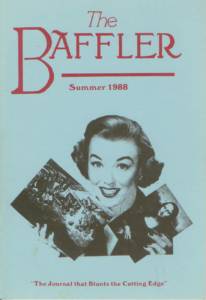
No. 1, Summer 1988: “The Journal that Blunts the Cutting Edge”
Who told us to start it? Nobody. Who was our billionaire? We didn’t have one. Well, why then? Because it felt like we were allergic to the world and we thought we should find out why. And so we generated a torrent of juvenilia. Our comic explication of “Mark Trail” remains worth reading. As do the cartoons and marginalia by David Berman. 1000 copies were printed in Charlottesville, Virginia and distributed to bookstores by the editors (Thomas Frank and Keith White) in person.
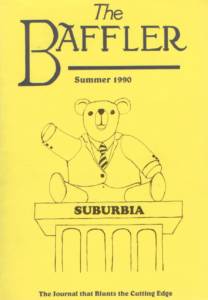
No. 2, Summer 1990: “Suburbia”
The yellow issue was conceived as an homage to those familiar fears of “mass society” and the great concern of decades past: conformity! “In a time when the ‘cutting edge’ has become a powerful tool for mediocratization,” our editor declared, “we proudly rededicate ourselves to its blunting.” Anxious-making midcult at the time included arts festivals sponsored by tobacco companies and the “affected playground cynicism” of nineties suburbanites.
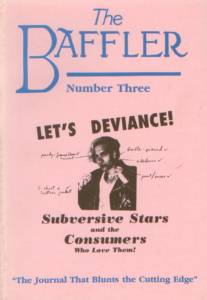
No. 3, Winter / Spring 1992: “Let’s Deviance!”
Baffler Number Three marks the first appearance of house anti-hero, Gedney Market, as well as the beginnings of The Baffler’s distinct style of cultural interpretation. To wit: Thomas Frank’s hipster demolition job and Rick Perlstein’s robust analysis of Scooby Doo.

No. 4, Spring 1993: “Twenty-Nothing”
The Baffler muscles its way into that great debate of the early 1990s: What exactly is Generation X? In their titular essay, Thomas Frank and Keith White tell the ad men and the Boomers to go pound sand. This is also the issue in which we introduce “Semiotics Mailbag,” our high-theory lifestyle advice column, and in which we reveal that a glossary of slacker slang printed by the New York Times was, in fact, made up, thus exposing what became known as the “Great Grunge Hoax”—and launching the phrase “swingin’ on the flippity flop” into the general lexicon.
The idea strikes us to boost bookstore sales by printing something provocative on the magazine’s spine. After rejecting one suggestion — “Not now, Caitlin, Mommy’s tattoo hurts” — we decide to go for straight-up insult: “Your lifestyle sucks.” It works. We’re on our way.
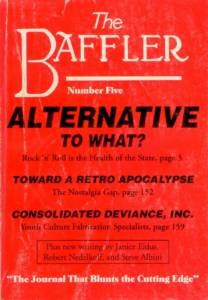
No. 5, Winter 1993: “Alternative to What?”
To fully appreciate this issue of the Baffler, you have to transport yourself to a time when the word “alternative” did not provoke a reflexive cringe. (Go back and watch the movie “Singles,” or just look at its theatrical release poster to get in the mood.) The war on corporate culture continues with Steve Albini’s “The Problem with Music,” an essay that compared the act of signing with a major label to traversing a trench filled with “runny, decaying shit.” Plus: Keith White’s legendary takedown of Details magazine. Then: Herbert Mattelart assails world music, Eric Iversen follows the search for the new Seattle, and Thomas Frank probes the nullity that is Pearl Jam. Maura Mahoney deflates the Beat revival, and Tom Vanderbilt wonders about the day when retro culture finally catches its own tail.
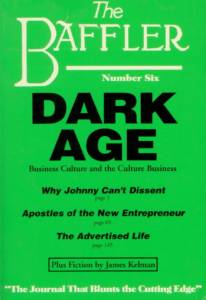
No. 6, Winter 1994: “Dark Age”
Thomas Frank’s “Why Johnny Can’t Dissent” is a once-in-a-generation lament that made punk rockers everywhere gasp at the futility of their attempts at rebellion. Meanwhile: Keith White turns his guns on Wired Magazine, Stephen Duncombe subjects himself to corporate edutainment and Seth Sanders braves the theme-restaurant wasteland of Chicago’s River North. Joanna Coles describes the collapse of publishing while Charles Bernstein finds a few signs of life. Will Boisvert decodes the management theorists. Tom Vanderbilt bemoans the imperial arrogance of advertisers. David Berman recalls his time as a security guard at the Metropolitan Museum of Art.
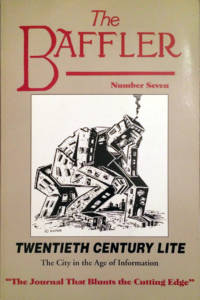
No. 7, Spring 1995: “Twentieth Century Lite”
A gimlet stare at what 20th c. capitalism has done for the American metropolis. Keith White reads city lifestyle magazines. Paul Lukas pays a visit to Times Square, then a retail wasteland. Naomi Klein hangs out at an online café. Maura Mahoney reads “Midnight in the Garden of Good and Evil” and finds it depicts Savannah, Georgia as a Southern Gothic theme park. Dave Mulcahey reflects on the “Screw Capital of the World”: Rockford, Illinois. Kim Phillips-Fein regrets how lotteries bilk the poor, and Stephen Duncombe rankles at the way cities police them. Plus: dialect fiction by Irvine Welsh.
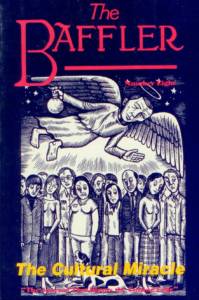
No. 8, Winter 1995: “The Cultural Miracle”
“For all its great cable channels, the excellent new global cyber capitalism is turning out to be a lot like the simple, grinding, exploitative capitalism of a hundred years ago,” writes Thomas Frank in the lead essay, in which he begins to explore the ways we deceive ourselves about our basic economic interests. Mike Newirth pours a nice frosty cosmo for the One Percent, while Tom Vanderbilt calls Skyy vodka’s marketing efforts “a Reaganite shibboleth charted in the barroom.” Aaron Cohen praises Thirties band-leader Artie Shaw; Artie Shaw remembers dealing with the music industry in the Thirties. Gary Groth reads Quentin Tarantino. Daniel Harris writes about gay porn in the age of AIDS.

No. 9, Spring 1997: “An Injury to All”
The New Economy is in full swing and we decide to do an issue on labor. It features Jim Frederick’s classic essay on the intern economy (the spine of the issue bore the slogan, “Interns Built the Pyramids”). Thomas Frank reminds us, once again, how class was disappearing as an interpretative category. Josh Mason examines the ephemera of bull-market culture, including a punk-rock investment magazine. Tom Vanderbilt rips into office culture, from Dilbert to Successories. Chris Lehmann writes on the intersection of class and labor in the American university. Dan Bischoff recalls the story of union-buster Henry Clay Frick; Frances Reed remembers the Lawrence, Massachusetts textile strike of 1912; Christian Parenti remembers prison labor and tells why it’s coming back. With fiction from Lydia Millet, a nod to authors-in-hiding by Robert Nedelkoff, and a cover by Mark Dancey.

No. 10, Fall 1997: “The Folklore of Capitalism”
An issue dedicated to business culture that features Matt Roth’s classic essay on Amway and how he happened to sign up for it. Also: Thomas Frank reads Babbitt. Tom Vanderbilt marvels at the ubiquity of branding. Nelson Smith provides a history of security alarms. Kim Phillips-Fein looks at the urban poverty initiative Bridges-to-Work. Mike Newirth remarks bitterly on the urban gentrification initiative known as Wicker Park. Stephen Duncombe questions why history books written by establishmentarians focus on underdogs. Seth Sanders reviews records, including Atari Teenage Riot’s first compilation and “Wu Tang Forever.”
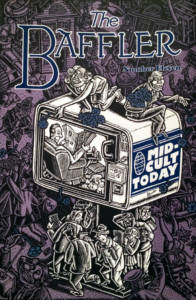
No. 11, Summer 1998: “Mid-Cult Today”
An issue on middleness, which starts out—of course—with an essay on “USA Today” and the theory behind it. Then: Ben Metcalf seethes at the Mississippi River. Paul Maliszewski confesses to the Swiftian fabulism he practiced while working as an editor at “The Business Journal of Central New York.” Tom Vanderbilt explores a California ghost town that has become a federally subsidized film set. Dan Kelly lunches with Rotarians. Kim Phillips-Fein explores the bankruptcy industry and the morality of indebtedness a full ten years before these issues dawned on the rest of the nation. Marc Cooper remembers where he was on September 11, 1973. Also: an entertaining epistolary exchange between Chris Lehmann and Michael Berube.
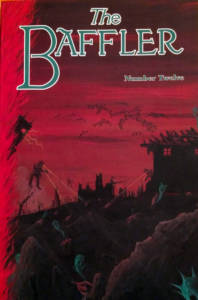
No. 12, Spring 1999: Good-Bad / High-Low (aka “Then Came Nylon”)
Contains Thomas Frank’s essay, “New Consensus for Old,” in which he trashes the academic field of cultural studies. Plus: Jim Arndorfer stands in awe of the multilayered historical simulacrum that is Fado Irish Pub. Stephen Duncombe marvels at Cadillac, the historical embodiment of the aspirations of the middle class. Bryan Urstadt gives a blow by blow account of the luxuries of a major automobile press jaunt. We unearth a forgotten fictional delicacy by Thomas Beer. Christian Parenti offers a slab of gritty reporting on the California prison system. Loic Wacquant translates Pierre Bourdieu’s treatise on neoliberal thought. Plus: Rock n roll is dead, and Mike O’Flaherty says that late capitalism killed it. Also: beautiful cover art by Patrick Welch.
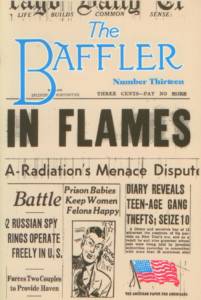
No. 13, Winter 1999: “Vox Populoid”
In which we kicked off our long-running study of American conservatism with a look at the nation’s long parade of kooks and cranks. In it, Jeff Sharlet remembers Westbrook Pegler, the “It Boy of attack journalism.” Dave Mulcahey remembers the backlash bible known as “Reader’s Digest.” Robert Nedelkoff remembers the Black godfather of American fascism. And Dan Raeburn remembers when the beloved comic strip “Li’l Abner” took its sharp turn to the right. Dan Kelly tells the anti-heroic story of the John Birch Society. Daniel Lazare traces the career of The New Criterion’s Hilton Kramer. Christian Parenti singlehandedly launches the discipline of Seventies Studies with an essay about wildcat strikes. Paul Maliszewski tells the Rest of the Story about his tenure at the “Business Journal of Central New York.” With microfilm-pastiche art by Hunter Kennedy and fiction by Aleksandar Hemon.
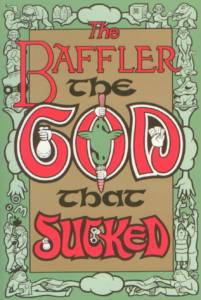
No. 14, Spring 2001: “The God That Sucked”
An issue about that ungracious deity, the Market, which starts off by wondering why Americans continue to love their shabby god even when it most assuredly doesn’t love them back. Mike Newirth narrates the awful story of the gun culture. Josh Glenn blames youth quiescence on the brainwashing power of OK Soda. Clive Thompson describes Conrad Black’s effort to bring an American-style backlash to Canada. Earl Shorris recalls his personal fight with the neocons. Chris Lehmann traces the long history of the liberal-media myth. “Harper’s” magazine publisher John R. MacArthur remembers the backlash election of 1972 and the sparsely populated political group, Republicans for McGovern. Martha Bridegam ponders the beginnings of the real-estate bubble in booming San Francisco. With fiction from Christopher Sorrentino and Leon Forrest, plus an illuminated cover by Mark Dancey that should rightfully front every Baffler ever. A classic, and also the number that was at the printer when fire destroyed the Baffler office in Chicago.

No. 15, November 2002: “Civilization With a Krag”
The Global War on Terror has begun, and Ian Urbina and Chris Toensing tell of a colorful military clique wallowing happily in the new wave of defense dollars. Thomas Frank makes a pilgrimage to the Super Bowl. Martha Bayne appraises the cult of culinary excellence surrounding a certain celebrity chef. Andrew Friedman gets beneath the swirly titanium skin of the Bilbao Guggenheim. Terri Kapsalis draws frightening parallels between artificial insemination and American Girl dolls. Sharon O’Dair tells of the ne plus ultra in scholarly self-absorption: academic memoirs. J.D. Connor reads a submarine movie as a glorified deal memo for a corporate merger. Seth Sanders and Mike O’Flaherty remember rock music’s part in the backlash. With poetry from Daniel Bouchard.
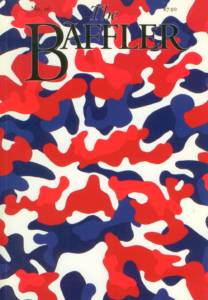
No. 16, Spring 2003: “NASCAR, How Proud a Sound!”
The backlash is back, the New Economy is dead, and Thomas Frank does a close reading of Ann Coulter, uncovering the remarkable similarities between the newest of rights and the oldest of lefts. Kenneth Neil Cukier reminisces about the salad days of New Economy journalism. Steve Featherstone reminisces about the management practices of New Economy offices. Paul Maliszewski writes the original and to this day the most thorough demolition of Richard Florida’s “creative class” theory. Dan Raeburn rescues the reputation of Baffler household god H.L. Mencken. Ana Marie Cox reads paperback potboilers. Dubravka Ugresic remembers happy days under Communism. Dan Kelly builds plastic models of movie monsters.
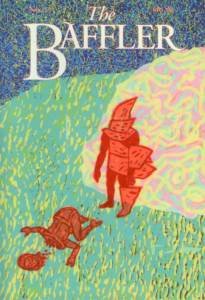
No. 17, Spring 2006: “Superslayer Storybook”
Another memorable issue, this one produced in Chicago and Washington, D.C., at the tippy-top of the real-estate bubble. Thomas Frank describes the Washington culture of centrism. Thomas Geoghegan tells what inequality does to the rule of law. Andrew O’Hagan remembers where he was when William S. Burroughs died. Jim Arndorfer reveals how the fortune of a Milwaukee plutocrat helped to change the nation’s politics. Kim Phillips-Fein understands online poker as a symbol for bubble-time economics. Steve Evans describes the rise of backlash poetry and “Free-Market Verse.” Jim McNeill honors labor bureaucrat Victor Reuther. Catherine Liu observes the ultimate commodification of dissent in Singapore. Matt Weiland marvels at Chautauqua re-enactors. With fiction from Martin Riker and Whitney Terrell.
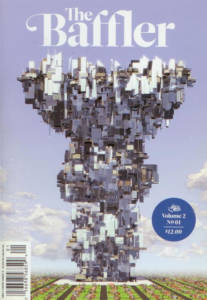
No. 18, Winter 2010: “Margin Call”
Then came the crash. Old media has kicked the bucket, and so has the economy. The old Baffler crew re-emerges one last time to say we told you so . . . with full-color art and a built-in ribbon bookmark. Christine Smallwood considers the difficulty of thinking about the Internet. Astra Taylor asks about the meaning of “free” in an age of digital piracy. Michael Lind resurrects the word “oligarchy.” A.S. Hamrah links the work of the painter Thomas Kinkade to the mortgage bubble—an observation that would be quoted frequently when Kinkade died a few years later. Naomi Klein discusses the continuing relevance of her ten-year-old classic, No Logo. Will Boisvert remembers Detroit. Mike Newirth remembers Nelson Algren. Walter Benn Michaels tells us how Americans’ fixation on social virtue has blinded us to our economic regression. Matt Taibbi reads Rod Blagojevich. And Moe Tkacik drops an 8,000-word bomb on the literature of the financial crisis. “This issue of The Baffler was assembled in December 2009 in Chicago, Washington and New York after having been painstakingly ghostwritten by Bill Ayers,” reads the front matter. It was also the last issue edited by Frank and Mulcahey.

